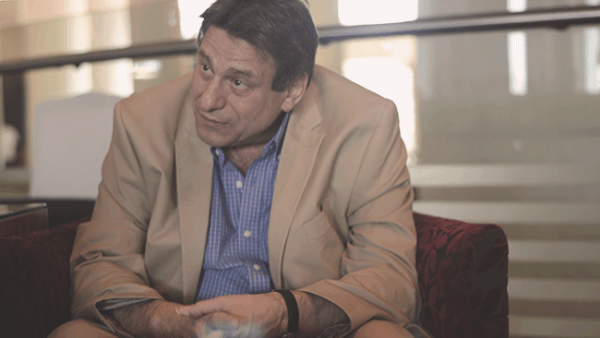Professor Richard Peña is unassuming. Meeting him, you’d think him a slightly shy, affable, and warm man. Talking to him, you realise he has swaths of knowledge and a fantastically powerful memory. Listening to him, you realise he has mastered the good teacher’s most difficult trick: the ability to impart both knowledge and understanding without making you feel patronised or talked down to.
But Professor Peña served as the program director of the Film Society of Lincoln Center, as the Professor of Professional Practice at the School of The Arts at Columbia University, and as Chairman of the Selection Committee of the New York Film Festival. Singing his praises are the likes of Michael Moore and Olivier Assayas. He is an expert on directors like Egypt’s Youssef Chahine, Iran’s Abbas Kiarostami, and France’s Sacha Guitry.

Above: Professor Peña. (Rami Khoury / Al Bawaba)
He’s earned both his stripes and reputation, and yet he'd come to Jordan to give a series of talks entitled "On the Margins of American Cinema." Attending two of these, I realised very quickly just how much deeper his knowledge of cinema—even my own forte, independent cinema—was than my own. I had to speak to him.
We met at a hotel lobby. The interview was originally scheduled for an hour, but we had to cut it down to 25 minutes to meet unforeseen circumstances.
**
So I think we should just cut straight to the chase. Well, actually, first: I’m curious about something.
Yeah?
It’s 1965. You got to the New York Film Festival. You’re dying to see The Wedding March. Why The Wedding March? It’s a surprising choice for a 12 year old.
Well, I’d read a book called The Liveliest Art, by Arthur Knight, which was one of the first popular histories of cinema that were available. And he spoke a lot about Erich von Stroheim, and it was less The Wedding March than Erich von Stroheim [the film’s director]. I just knew that his films were very rare and hard to see and supposedly quite interesting. So I thought, “This sounds good,” and, you know, there it was, playing a few miles from where I lived, and, "Oh, you really have to see this." And, you know, it was coming from the Cinémathèque Française and I’m not sure if I knew what that meant—in fact, I’m quite sure I didn’t know what that meant—but at least I knew it was quite a rare opportunity to see this.
Did you actually enjoy it?
Yeah, I did. It was a great film. Have you seen it?
I’ve actually never seen it.
Ah, well. You should.

Above: Richard Peña discusses The Wedding March. (Rami Khoury / Al Bawaba)
So you’re here in Jordan talking about “On the Margins of American Cinema.”
Right.
According to statistics, 70% of American films are made by what you call “vertically integrated Hollywood,” [which] reaps around 95% of the profits.
Right. Mm-hmm.
So why do you think the last 30% is interesting or important?
Well, I mean, it’s because they’re interesting artistically. I think they look at ideas and forms and things like that, which sometimes come back and can influence the mainstream, but more than that just exist as works of art. I don’t know how much money Maya Deren [co-director of renowned 1943 avant-garde film Meshes of the Afternoon] has made over the years, but I think Meshes of the Afternoon has influenced an enormous number of people, so it’s important as a work of art.
The BBC voted as one of the greatest forty American films of all-time.
That’s good!

Above: Professor Peña talking about independent cinema. (Rami Khoury / Al Bawaba)
Mm-hmm. Well.
As opposed to dependent.
Well, I actually think there are more than that, just…I mean, for example, I don’t have the material to actually do a presentation on the [Workers] Film and Photo League, which was a very important movement that started in the late 20s, early 30s, that were left-wing filmmakers and photographers who were aligned the labour movement and whatever who really put their own news reel and also made their own short films, an alternative news source, in a way. They’re great, but their work is very hard to show. There’s not much that’s available in any format. There’s [also] the New Left cinema from the 1960s that could show. There are a number of cases…these are just four moments, each of which has its own peculiarity.
So it’s not these four particular periods that—
No, no. I hope I didn’t imply that. I mean, for example, [at tonight’s talk], if I talk about a period, I mean something much longer than that.
So is there an avant-garde movement in the United States today?
Yeah, I mean, I think there are still people making that. And yet it’s lost a certain kind of connection to the public. It’s much smaller. This was something that in the 60s especially had a pretty wide following, and people were looking for alternatives and new ways of making film and stuff, and it had a real public, you know. It’s gone down since then, but I think people’s interest in things that are out of the mainstream has gone way down since then.
Do you think…things like Cinema 16 [a once-popular avant-garde film society]—actually, I tried to ask you about this a couple of days ago, during a Q&A—do you think things like avant-garde cinema and Cinema 16 came-out as a result of the United States changing from being a very idealistic country to [all the things that happened to the States from 1942 through the 60s]?
I think there were a lot of changes that went on in American society. In 1960, there was something like three times the number of Americans enrolled in university than there were in 1930. So there was a great new accent on higher education. I think people who, when they came back from the war, some people were a little dissatisfied with what they saw as the status quo of Hollywood. Which is why I think things like Italian neorealism should have created a new audience…And bit by bit, I think the idea of an alternative cinema began to grow. And the avant-garde, or experimental cinema, was a part of that…a much smaller part of that, but I think at that time there was a kind of lively interest.
And so it grew as film departments began in universities and things like that and more and more venues were established, so by the late 1960s, there was a fairly healthy network that had been set-up all over the United States of universities and film clubs and things like that where creators had a platform. That’s gone away, very largely, but certainly in the 60s, up through the mid, late 70s, it was quite active.
Do you think American audiences to some degree now have sort of been “trained” on how to watch movies, and are therefore less accepting of things that are—?
Not just American audiences, but all audiences. I mean, you know, in America we went through a period in the 50s and 60s where there was a certain of openness to all kinds of different things.
If a film like L'Avventura opened today in the United States, I’m sure it’d show at film festivals, but the idea that a film like that opened in four movie theatres in New York City in the 1960s is quite remarkable, when you think about it. It’s such a challenging work. But you had people back then who were looking for something different. I think there’s a different attitude towards culture.

Above: From L'Avventura (1960). (Cino Del Duca)
I think, really, it began in the Reagan-Bush years. There was a real turn into a much more conservative approach to culture. It came back a little back in the Clinton era in [the sense that] it had a much more international outlet to accept more things that were non-American, although I don’t know if there was that much, necessarily, [experimenting] with form. But, you know, it’s how these things happen.
I would argue that film schools were largely responsible for this. That, you know: “Here’s Citizen Kane. Just do what Orson Welles did.”
True, they did that. I think what really happened more than anything was that, especially as time went on, there was more and more of an accent that, if you should go to film school, it should be really useful for you. “You should really learn how to make films. You should really figure-out how to join the industry.” So I think some film schools were oriented in that direction. For a long time, film schools were much more open, creative, but then people started saying, “Yeah, but I’m coming out of it with a degree, I paid $75,000 for it, and I can’t get a job.” So I think it became more and more (waves his hand)…although there are places, for example, where they teach experimental filmmaking. Like Columbia, which [has] much more of an art film orientation.
I've actually always wanted to visit.
(smiling) Mm!
Four years ago, you stepped down from being Chairman of the Selection Committee at the New York Film Festival.
Yes.
Do you miss it?
No.
At all?
No.
Too much pressure?
I did it for 25 years, and no pressure at all. I could have stayed as long as I wanted. I’d just done it, and then you get up one morning and you think, “Do I really want to do this the rest of my life?” And you say, “No.” I mean, I’d done it, it was great, I had wonderful challenges, really wonderful time, but I couldn’t do this (indicating the table and smiling) if I was still Chairman of the Selection Committee at the New York Film Festival. So I thought that it’d be nice to spend my time travelling, and teaching, and doing more writing, and just having summers that were free.
Could I get your opinion as the former Chairman on something that happened this year?
Yep!
At the Cannes Film Festival.
Yep.

Above: From The Meyerowitz Stories (New and Selected), a point of controversy at Cannes. (Netflix)
There was controversy this year regarding to films, which Netflix had funded: Okja and The Meyerowitz Stories. But both these films were made by auteurs, which is something that Hollywood does not seem interested in doing anymore. And yet people like Pedro Almodóvar, who is a very good filmmaker, said: no, we should not be supporting Netflix [and these films shouldn’t be at the festival]. Do you agree?
I think that’s a little small, as a position. I think platforms for productions change over the years. We wouldn’t have had New German cinema had German television not paid for New German cinema—you know, they paid for those films with the [provision] that in a year, eighteen months, they’d be on TV. But first they’d be exploited theatrically. You know, I think the history of funding for especially specialised films has gone through different periods and maybe we’re entering a Netflix-Amazon period now. I don’t think necessarily for the good, but it’s a reality, and I don’t think we should penalise films because that’s where they got their money.
There was an interview today with [Dunkirk director] Christopher Nolan where he said that Amazon is not the same as Netflix, the difference being that Amazon allows movies to play for ninety days at the cinema before streaming it. Netflix doesn’t. According to him, that was the problem.
Well, I mean each one has a policy, you sign-up with whichever one offers you a deal. Netflix I think has offered a number of different kinds of deals for people, depending on who you are and what your product is. But their interest, obviously, is getting more people to sign-up for Netflix. Having a theatrical window must be a loss for them.
Do you like to watch films on Netflix?
I watch some on Netflix. It just depends. I go to movies a lot, too. But if I’m home and I want to watch something, I probably use Netflix more for series’ or things like that, or maybe documentaries, British documentaries that I wouldn’t see somewhere else.
I’m guessing you’re one of those people who likes to watch movies on a 70mm screen with—
I like to watch movies as movies, but I’m less a cellular junkie than a lot of other people.
You’re not a purist.
Not at all.

Above: Professor Peña seemed to enjoy the interview more and more as it went along. (Rami Khoury / Al Bawaba)
Do you still keep-up with the New York Film Festival?
Of course.
Do you attend?
Of course!
Was there ever a year during your “reign,” as it were, that you were especially proud of?
Yeah, there were a couple of years. I mean, again, it’s a funny job because you’re really dependent on what’s there. And every now and then there’s just a year where it seems like all these terrific films are available to you [that] you’re glad to present. There were never years where I was ashamed of what we were showing, but there were years where you felt strongly about the work…2011 was a very, very strong year, I’m very proud of that year. It was the first year where we had the Elinor Bunin Munroe Film Center, which is the film centre we opened in June of 2011. We came-up with a wonderful, elegant way of integrating it with everything else. I think that was a very good year.
And there were a few other years where everything just came right. But in the end, you don’t make ‘em. So suddenly you might have five or six films that might mean a lot to you, and they’re all in one year.
New York’s a hubbub of very rich culture. Not just films, but novelists and music…You’ve got everyone from Philip Roth to Woody Allen. So I was wondering. Historically, you’ve been interested in lots and lots and lots of directors from around the world. You’ve got Yasujirō Ozu [director of Floating Weeds] from Japan, for example, you’ve got Youssef Chahine [director of Cairo Station] from Egypt. Somebody like you grew-up in Manhattan…what do you think differentiates American [culture] from Japanese or Arabic culture, for example, in terms of what they mean [to American audiences]?
That’s a huge question. I’d say that Hollywood developed a certain way of telling [stories] and that way of telling [stories] became enormously influential around the world. It’s varied somewhat from, say, the 1940s, but essentially a kind of narrative style still really dominates what Hollywood does. There are certain foreign directors who also follow in that general direction and also there are some directors who work in a more personal or idiosyncratic style. So there’s a lot of that. What can I say? American films have also dominated world cinema since about 1918…It’s an enormous industry, it doesn’t really need film festivals or that kind of stuff, whereas I think the others do, maybe.

Above: Professor Peña considers the question. (Rami Khoury / Al Bawaba)
One thing you said about avant-garde films was that they “went against conventional Hollywood narratives.” And I was wondering what you meant. Did you mean like hero-antihero, or story structure—
I think these are real ways that Hollywood told films. A kind of linear narrative, events are put into cause and effect relationships in a space-time continuum that’s clearly communicated and understood by the audience. They usually use protagonists who become our guides through these narratives, protagonists made-up of a certain number of traits that are sometimes contradictory. The films move towards conclusion, towards a resolution. There are a lot of ways you can really describe Hollywood films that really encompasses how they’re mainly made.
So your argument is that this is an American way of telling stories, and not just a good way of telling stories?
Well, it’s the way Americans had developed it. It certainly had existed in literature and other places, but I think American cinema took a certain storied style that had developed in…let’s just say “Western culture,” especially in the 19th century, and adapted it into the twentieth century.
Hmm. See, the reason I’m asking is last night I was re-watching a Korean film.
Mm-hmm.
I don’t know if you’ve seen it. It’s called Memories of Murder.
(enthusiastically) Yes! I know it well.
Do you like that film?
I do!
It’s one of my personal favourites. One thing about it is it doesn’t have some sort of clarity, which is intentional, but at the same time, it was the number 1 movie in the South Korean box office that year. There was a really good essay that I read which argued that the film spoke to South Koreans the way something like a John Wayne film would have spoken to Americans in the 1960s. But it’s hard to translate that to how America sees itself through movies. It’s always been: hero. And then Bonnie and Clyde and New Hollywood and it’s all antiheroes. Now we’re back to Marvel and heroes.
Things are never that mechanical. Remember, there are 320 million of us, so it’s hard to find anything that satisfies all of us. When you say “American style,” it’s going to be a style that appeals to some Americans and not a lot to others. I think in the case of something like Memories of Murder or things like that…what you’ll find in a lot of Asian narratives is what you may think of as “group portraits,” where you understand a whole strata of people and what they’re doing. And that’s a kind of old narrative tradition [in Asia], where essentially you don’t focus on a character, the character is simply part of a group and you learn about the dynamics of the group. And I think some South Korean narratives very much work in that way, and I think they draw upon a tradition where people understand that to be a completely acceptable narrative form.
It’s not necessarily that difficult or impossible for others to understand, but it’s less like the way [Americans] tend to tell stories.

Above: Professor Peña towards the end of the interview. (Rami Khoury / Al Bawaba)
See, the reason I ask is I’m Arab. And I think a lot about Arabic culture and story structure and—
But you also have a lot of other influences. Being an Arab is something in your background. It doesn’t say anything about your culture.
But that’s it, see. I think about stuff like what differentiates Arabic storytelling from South Korean, for example.
Well, you go back and look at how people in Arabic culture learned to tell stories. You read One Thousand and One Nights or whatever and see how that compares to Dante’s Inferno. There’s lots of ways that people tell different stories. There have been many different styles over the years, coming from different cultures.
But you have to realise that culture is never a fixed thing. When culture’s a fixed thing, that’s when it’s dead. And as long as it’s alive, it’s always changing. It’s always reacting to foreign influences and things like that.
(At this point, we notice the interview will be wrapping-up in five minutes.)
Wow. I have so many questions, too. OK. Let’s just do this the New York Times way.
(laughs) Yeah.
Last great film you saw?
Oh boy. Last great film I saw. It was just in Paris…I really liked the last Claire Denis film. [Let the Sunshine In]
Last film that made you laugh?
Last film that made me laugh. Probably the Claire Denis film.
Last film that made you cry?
(laughs) I can’t think of anything that made cry recently. Older films make me cry more frequently.
For example?
You know, when I see, for example…Salt of the Earth. It’s a 1954 film made by three…Americans about a mining strike. And there was a tremendous campaign against it, practically censored it. But [it was] discovered years later.
Any films you’re really excited to see this year?
Yeah. Since I don’t go to festivals anymore, sometimes I just read about them. And if there’s a film that sounds very good or is by someone whose work I know and respect…I look forward to seeing what people come-up with. I think the Argentine director Lucrecia Martel has a new film [entitled Zama]. It wasn’t at Cannes, partially because one of the producers of the film was Pedro Almodóvar, [who] couldn’t be president of the jury and have a film that he’d co-produced in the competition. So I’m assuming it’ll be in Venice. And, after Venice, I’m assuming it’ll be at the New York Film Festival. So I very much look forward to seeing it when I can. She’s one of my favourite directors.
Young and upcoming filmmakers whose work you’re excited for.
Yeah. Another one of those films I really liked was the new Hong Sang-soo film that’s out. The Day After. But he’s somebody who’s up and down. He’s somebody who works an awful lot, so he’ll make three films every two years, and I will say that, of those three, one is usually really great. The other two are OK. He just likes to work like that. He’s like [Rainer] Fassbender. Just likes to churn them out. Fassbender, in the end, of the 41 films, 10 were really great. But the others weren’t as great.
Is he the guy who made Right Now, Wrong Then?
(laughs) Yes!
Ah, OK. One last question, then, but it’s different from the bunch above. I watched one of your talks where you said American films follow a structure of, “Problem, addressing the problem, conclusion.” I wondered if you had any alternative story structure in mind that filmmakers could benefit from.
Well…you could actually make a lot of great stories with that structure. But, for example, I love Renaissance painting. I don’t think everyone should paint like they did in the Renaissance. It’s there, and it’s very difficult to achieve the circumstances that produced that great art. I’m glad that there was cubism, though, that violated all those rules. Similarly, I think that it is great that there are classical Hollywood films and the way it worked. I’d just like people to know that it’s not the only way to make films.
I think ambiguity and things like that [are alternatives]. I like movies that play a little more with the audience. When I started going to movies seriously in my teens, I liked going to movies that were adventures. It was an adventure to see a film and not really understand it, not really know what it’s about and feel lost and feel the need to talk about it with friends, to see it again or read about it. I really liked that sensation. And I think not enough of my fellow countrymen do. I think they want things that are easily packaged and know exactly what they’re going to get. And if they don’t get it, they get disappointed or even angry, feeling somehow that the film has betrayed them.
So you go see Batman 8 because you know exactly what it’s gonna be. It could be well-done, it could be not so well-done, but it’s not really stray too far from the model. Whereas some of these other directors, you don’t know what you’re really gonna get. I mean, watching the movie is at all moments a kind of adventure. And that is, for me, something I really prize in cinema.
Something that lingers.
Not just something that lingers, but something that really engages me. I feel I’m not just watching someone go through the motions, but I’m actually discovering something alongside the process of it being created. I like films that are really an adventure, in some way. I really liked the last Arnaud Desplechin. It’s called Ismael’s Ghosts. It was at Cannes…it got a lot of negative press.

Above: From Ismael's Ghosts. (Magnolia Pictures)
He’s a friend, so I saw him and I told him how much I disagreed with the press, because I felt like it was just him being loose. A lot of his films have such a perfection to them. He’s such a good filmmaker, very crystalline. And this time he just let go. And it was great to see him let go like that. Whether he’ll continue to do that or not, I don’t know, but this film it really felt like he was getting out a lot of energy that he had stored-up. But! Even his fans, a lot of critics were behind him, didn’t really accept it. They said, “Oh, the film’s a mess, and this doesn’t add-up,” and I said, “That’s so trivial. That’s not at all what’s so great about it.” But. (shrugs)
Thank you very much, Professor Peña.
Thank you! My pleasure.
Written by Karim Anani. Photography by Rami Khoury.







